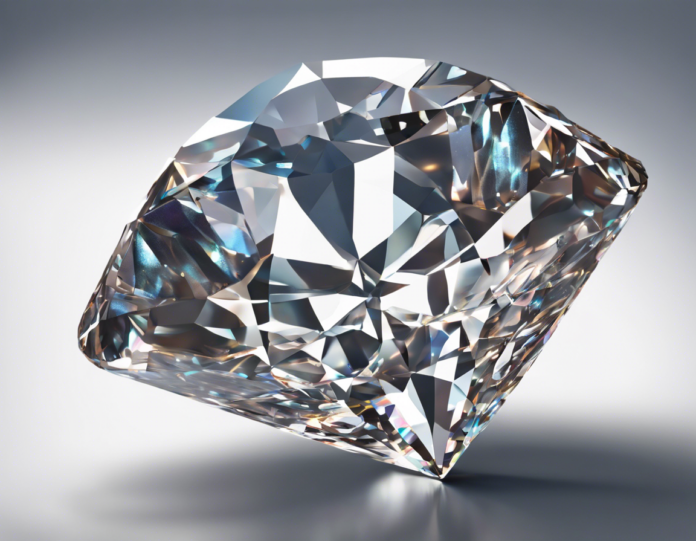When it comes to classifying materials, the distinction between metals and non-metals is fundamental in the field of chemistry. Diamond, although known for its hardness and stunning appearance, is not classified as a metal but rather falls under the category of non-metals. In this article, we will delve into the reasons behind this classification and explore the unique properties of diamond that set it apart from metals.
What is Diamond?
Diamond is a crystalline form of carbon, where each carbon atom is arranged in a strong, tetrahedral structure, creating a three-dimensional network. This unique arrangement is what gives diamond its exceptional hardness and durability, making it one of the hardest materials known to man. The carbon atoms in diamond are bonded together through strong covalent bonds, which contribute to its robust structure.
Properties of Diamond
1. Hardness:
One of the most renowned properties of diamond is its remarkable hardness. On the Mohs scale of mineral hardness, diamond ranks at the very top with a score of 10, making it the hardest naturally occurring material.
2. Transparency:
Diamond possesses excellent transparency, allowing light to pass through easily. This property is what gives diamond its brilliant sparkle and luster.
3. Thermal Conductivity:
Diamond exhibits exceptional thermal conductivity, which is higher than that of any metal. This property makes diamond an excellent heat conductor, leading to its use in various industrial applications.
4. Electrical Insulator:
Unlike metals that conduct electricity, diamond is an excellent electrical insulator. The strong covalent bonds between carbon atoms prevent the movement of electrons, thereby inhibiting electrical conductivity.
Why Diamond is Not a Metal
1. Atomic Structure:
The primary factor that distinguishes diamond from metals is its atomic structure. Metals are characterized by having mobile electrons that allow for electrical conductivity. In contrast, diamond's tightly bound carbon atoms do not possess free electrons for conduction, rendering it a poor conductor of electricity.
2. Bonding Nature:
Metals typically exhibit metallic bonding, where electrons are delocalized and free to move throughout the material. In diamond, the covalent bonds between carbon atoms are localized, leading to a rigid structure that lacks the electron mobility seen in metals.
3. Physical Properties:
While diamond shares some properties with metals, such as high thermal conductivity and hardness, its overall behavior and characteristics align more closely with those of non-metals. The absence of metallic bonding and electron delocalization are key factors in classifying diamond as a non-metal.
Common Myths about Diamond
Myth 1: Diamond is the Hardest Substance on Earth.
While diamond is indeed the hardest naturally occurring material, there are synthetic materials and substances, such as nanomaterials and agarwood, that can rival or even surpass diamond in terms of hardness.
Myth 2: All Diamonds are Clear and Colorless.
Diamonds come in a variety of colors, including yellow, blue, pink, and black. These colors are due to impurities or structural defects within the crystal lattice of the diamond.
Myth 3: Diamonds Cannot Burn.
Although diamond is highly resistant to heat and combustion, it is not entirely immune to burning. At very high temperatures in the presence of oxygen, diamond can indeed burn and be converted to carbon dioxide.
FAQs about Diamond Classification
1. Is diamond considered a metal?
No, diamond is classified as a non-metal due to its covalent bonding structure and lack of metal properties such as electrical conductivity.
2. What are some industrial uses of diamond?
Diamond has diverse industrial applications, including cutting, grinding, drilling, and as a heat conductor in electronics.
3. Can diamond conduct electricity?
Diamond is an excellent electrical insulator due to its tightly bonded carbon atoms, which restrict the flow of electrons.
4. How does diamond compare to other non-metals?
Diamond stands out among non-metals due to its hardness, thermal conductivity, and transparency, setting it apart from most non-metallic materials.
5. Are there any exceptions where diamond behaves like a metal?
Under extreme conditions, such as high pressure, diamond can undergo structural changes that may exhibit properties similar to those of metals, but this is not its typical behavior.
In conclusion, while diamond possesses exceptional properties that make it unique among materials, its classification as a non-metal is based on its atomic structure, bonding nature, and overall physical properties. Understanding these distinctions helps us appreciate the diversity and complexity of materials in the world around us, showcasing the beauty and marvel of diamond as a non-metallic wonder.

